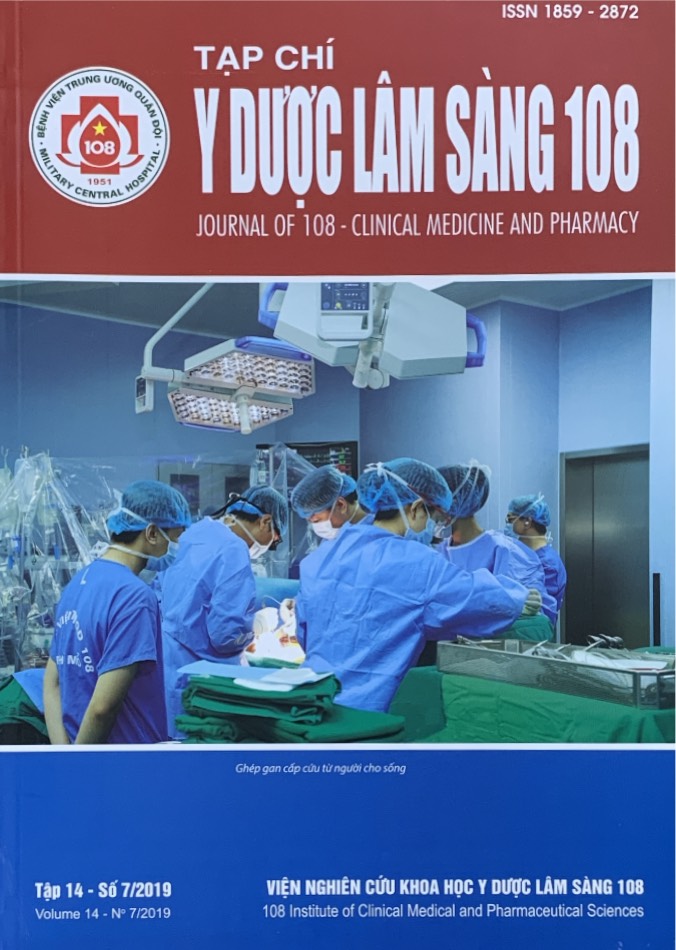Evaluate result of nursing patients after removal of common bile duct stone by endoscopic retrograde cholangiopancreatography in 108 Military Central Hospital
Main Article Content
Keywords
Abstract
Objective: Describing characteristics and analyzing care results of patients with removing common bile duct stone by endoscopic retrograde cholangiopancreatography (ERCP). Subject and method: Progressive and cross-sectional study, 111 patients were treated to remove gallstone by endoscopic retrograde cholangiopancreatography in 108 Military Central Hospital from January 2019 to July 2019. Result: Mean age of study group was 65.59 ± 16.61 years, male accounted for 56.76%, and female accounted for 43.24%, history of gallstone removal surgery accounted for 27.03%. Clinical symptoms before the intervention including pain (84.7%), fever (65.77%), jaundice (61.26%). Most clinical and subclinical symptoms significantly improved after the intervention. Few patients had to be inserted urinary catheter into bladder and stomach, using painkillers and muscle relaxants after the intervention, well obeying care regime. Duration of taking feeding back and hospitalization were short. Conclusion: ERCP is a minimal invasive method that was most used to remove gallstones in distal extrahepatic bile duct. This is a relatively safe procedure with many clinical benefits, but there are also some potential risks. The efficacy of intervention has a great contribution of the health care process after post-intervention.
Article Details
References
2. Mai Hồng Bàng (2012) Nghiên cứu nội soi mật tuỵ ngược dòng trong chẩn đoán và điều trị sỏi, giun ống mật chủ tại Bệnh viện TWQĐ 108. Tạp chí Y - Dược học Quân sự, tập 4, tr. 65-70.
3. Đào Xuân Cường và cộng sự (2012) Ứng dụng nội soi mật - tuỵ ngược dòng để điều trị sỏi ống mật chủ và ống gan chung tại Bệnh viện Đa khoa Kiên Giang. Tạp chí Y học thực hành, các tập 1(2832, 2833), tr. 62-67.
4. Trần Thị Hảo, Đặng Thị Kim Oanh (2008) Nghiên cứu đặc điểm lâm sàng, hình ảnh siêu âm và dấu ấn khối u CA19-9 và CEA ở bệnh nhân vàng da tắc mật. Luận văn thạc sỹ y học. Trường Đại học Y Hà Nội.
5. Nguyễn Khánh Trạch (2008) Chụp đường mật - tuỵ ngược dòng qua nội soi tá tràng. Nội soi tiêu hoá, Nhà xuất bản Y học, tr. 171-181.
6. Nguyễn Quang Trung (2012) Nghiên cứu đặc điểm lâm sàng, cận lâm sàng và thái độ xử trí sỏi đường mật chính ở người cao tuối. Luận án Tiến sĩ y học, Học viện Quân y, Hà Nội.
7. Blackbourne LH (1994) The Sensitivity and role of ultrasound in the evaluation of biliary obstruction. Am Surg: 683-689.
8. Elmunzer BJ (2017) Reducing the risk of post-endoscopic retrograde chlangiopancreatography pancreatitis. Digestive Endoscopy 29(7): 749-757. Doi:10.1111/den.12908.
9. Jonston EV, Anson BJ (1994) Variations in the formation and vascular relationships of the bile ducts. Surg Gynecol Obstet: 669.
 ISSN: 1859 - 2872
ISSN: 1859 - 2872
